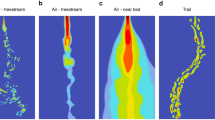Abstract
We have examined the fine structure of dorsal rim ommatidia in the compound eye of the three odonate species Sympetrum striolatum, Aeshna cyanea and Ischnura elegans. These ommatidia exhibit several specializations: (1) the rhabdoms are very short, (2) there is no rhabdomeric twist, and (3) the rhabdoms contain only two, orthogonally-arranged microvillar orientations. The dorsal rim ommatidia of several other insect species are known to be anatomically specialized in a similar way and to be responsible for polarization vision. We suggest that the dorsal rim area of the odonate compound eye plays a similar role in polarization vision. Since the Odonata are a primitive group of insects, the use of polarized skylight for navigation may have developed early in insect phylogeny.
Similar content being viewed by others
References
Armett-Kibel C, Meinertzhagen IA (1983) Structural organization of the ommatidium in the ventral compound eye of the dragonfly Sympetrum. J Comp Physiol [A] 151:285–295
Brunner D, Labhart T (1987) Behavioural evidence for polarization vision in crickets. Physiol Entomol 12:1–10
Corbet PS (1983) A biology of dragonflies. Classey, Oxon
Eguchi E (1971) Fine structure and spectral sensitivities of retinular cells in the dorsal sector of compound eyes in the dragonfly Aeschna. Z Vergl Physiol 71:201–218
Fent K (1985) Himmelsorientierung bei der Wüstenameise Cataglyphis bicolor: Bedeutung von Komplexaugen und Ocellen. PhD Thesis, University of Zürich
Horridge GA (1969) Unit studies on the retina of dragonflies. Z Vergl Physiol 62:1–37
Kolb G (1986) Retinal ultrastructure in the dorsal rim and large dorsal area of the eye of Aglais urticae (Lepidoptera). Zoomorphology 106:244–246
Labhart T (1980) Specialized photoreceptors at the dorsal rim of the honeybee's compound eye: polarizational and angular sensitivity. J Comp Physiol [A] 141:19–30
Labhart T (1988) Polarization-opponent interneurons in the insect visual system. Nature 331:435–437
Labhart T, Nilsson DE (1989) Sensitivity boosting in the photoreceptors of the dorsal compound eye of the dragonfly Sympetrum. Eur J Neurosci 1 [Suppl]:220
Labhart T, Hodel B, Valenzuela I (1984) The physiology of the crickets compound eye with particular reference to the anatomically specialized dorsal rim area. J Comp Physiol [A] 155:289–296
Labhart T, Meyer EP, Schenker L (1992) Specialized ommatidia for polarization vision in the compound eye of cockchafers, Melolontha melolontha (Coleoptera, Scarabaeidae). Cell Tissue Res 268:419–429
Laughlin SB, McGinness S (1978) The structures of dorsal and ventral regions of a dragonfly retina. Cell Tissue Res 188:427–447
Meinecke CC (1981) The fine structure of the compound eye of the African armyworm moth, Spodoptera exempta Walk. (Lepidoptera, Noctuidae). Cell Tissue Res 216:333–347
Meinertzhagen IA, Menzel R, Kahle G (1983) The identification of spectral receptor types in the retinal and lamina of the dragonfly Sympetrum rubicundulum. J Comp Physiol [A] 151:295–310
Meyer EP, Labhart T (1981) Pore canals in the cornea of a functionally specialized area of the honey bee's compound eye. Cell Tissue Res 216:491–501
Nilsson DE, Labhart T, Meyer EP (1987) Photoreceptor design and optical properties affecting polarization sensitivity in ants and crickets. J Comp Physiol [A] 161:645–658
Ninomiya N, Tominaga Y, Kuwabara M (1969) The fine structure of the compound eye of a damselfly. Z Zellforsch 98:17–32
Philipsborn A von, Labhart T (1990) A behavioural study of polarization vision in the fly, Musca domestica. J Comp Physiol [A] 167:737–743
Rossel S, Wehner R (1986) Polarization vision in bees. Nature 323:128–131
Wehner R (1982) Himmelsnavigation bei Insekten. Neujahrsblatt Naturforsch Ges Zürich 5:7–132
Wehner R, Strasser S (1985) The POL area of the honey bee's eye: behavioural evidence. Physiol Entomol 10:337–349
Wehner R, Bernard GD, Geiger E (1975) Twisted and non-twisted rhabdoms and their significance for polarization detection in the bee. J Comp Physiol 104:225–245
Author information
Authors and Affiliations
Rights and permissions
About this article
Cite this article
Meyer, E.P., Labhart, T. Morphological specializations of dorsal rim ommatidia in the compound eye of dragonflies and damselfies (Odonata). Cell Tissue Res 272, 17–22 (1993). https://doi.org/10.1007/BF00323566
Received:
Accepted:
Issue Date:
DOI: https://doi.org/10.1007/BF00323566




